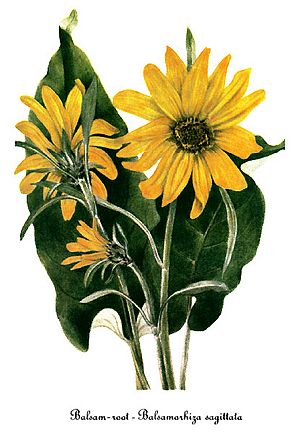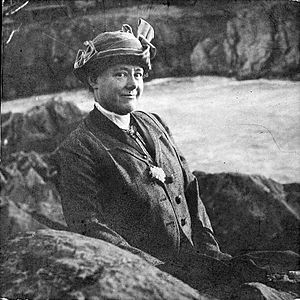Mary Vaux Walcott facts for kids
Quick facts for kids
Mary Vaux Walcott
|
|
|---|---|
 |
|
| Born |
Mary Morris Vaux
July 31, 1860 Philadelphia, PA
|
| Died | August 22, 1940 (aged 80) Saint Andrews, New Brunswick
|
| Nationality | United States |
| Scientific career | |
| Fields | Botany, Geology |
| Institutions | Smithsonian Institution |
| Author abbrev. (botany) | M.Walcott |
Mary Morris Vaux Walcott (born July 31, 1860 – died August 22, 1940) was an American artist and a person who studied nature. She was famous for her beautiful watercolor paintings of wildflowers. People even called her the "Audubon of Botany" because she was so good at painting plants, just like John James Audubon was famous for painting birds.
Contents
Mary Vaux Walcott's Life and Adventures

Mary Vaux was born in Philadelphia, Pennsylvania. Her family was wealthy and belonged to a group called the Quakers. After finishing school in 1879, she became very interested in painting with watercolors.
When she wasn't helping on the family farm, Mary painted wildflowers. She found these flowers during family trips to the Rocky Mountains in Canada. On these summer trips, she and her brothers also studied mineralogy (the study of minerals). They also drew and took photos to record how glaciers (large sheets of ice) were moving. These trips made her very interested in geology (the study of Earth's rocks and soil).
In 1880, Mary's mother passed away. At just 19 years old, Mary took on the important job of caring for her father and two younger brothers. After 1887, she and her brothers went back to western Canada almost every summer. During this time, she became an active mountain climber and loved being outdoors. She also became a photographer.
One summer, a botanist (a scientist who studies plants) asked her to paint a rare flower called arnica. This encouraged her to focus on drawing plants. She spent many years exploring the rough mountains of the Canadian Rockies. She wanted to find important flowering plants to paint. On these trips, Mary Vaux became the first woman to climb Mount Stephen, which is over 10,000 feet high. In 1887, she took her first long train trip across the country. She wrote an interesting travel journal about her family's four-month journey through the American West and the Canadian Rockies.
In 1914, when Mary Vaux was 54, she married Charles Doolittle Walcott. He was a paleontologist (a scientist who studies fossils) and the head of the Smithsonian Institution. Her father was very against the marriage. Mary played an active part in her husband's projects. She went back to the Rockies with him many times and kept painting wildflowers.
In 1925, the Smithsonian published about 400 of her paintings. These were in a five-book series called North American Wild Flowers. Each painting had a short description. The money from these books went to help the Smithsonian. In Washington, Mary became a close friend of First Lady Lou Henry Hoover. She helped raise money to build a meeting house for Quakers. This was so the first Quaker President and his wife could have a proper place to worship. From 1927 to 1932, Mary Vaux Walcott was part of the federal Board of Indian Commissioners. She traveled widely across the American West, visiting Native American reservations.
When she was 75, she traveled to Japan for the first time. She went to visit her lifelong friend, Mary Elkinton Nitobe. Mary Nitobe was also a Quaker from Philadelphia who had married a Japanese diplomat named Inazo Nitobe.
In 1933, Mary Walcott was chosen as the president of the Society of Woman Geographers. In 1935, the Smithsonian published Illustrations of North American Pitcher-Plants. This book included 15 paintings by Walcott. After her husband passed away in 1927, Mary Walcott created the Charles Doolittle Walcott Medal to honor him. This medal is given for scientific work about very old life and history from the Precambrian and Cambrian periods. Mary Walcott died in St. Andrews, New Brunswick in 1940.
Mary Walcott's Thoughts on Nature
Mary Walcott loved being outdoors. She wrote about her experiences in nature.
She once wrote about using a camera in the field: "A camera is a very delightful addition, because it's nice to have some clear pictures to show when you get home. Even a small Kodak camera gives good results. But bigger cameras give even better pictures if you are patient and skilled." - From "Camping in the Canadian Rockies"
She also wrote about measuring glaciers: ""The glaciers must be measured, and I hope to use the camera seriously, and get all I can. Last summer's work was such a disappointment in photographic results." - From a letter to Charles Walcott, April 1, 1912.
And about her love for the outdoors: "Sometimes I feel that I can hardly wait till the time comes to escape from city life, to the free air of the everlasting hills." - From a letter to Charles Walcott, February 19, 1912.
Mary Walcott's Legacy
When Mary Vaux Walcott died in 1940, she left $400,000 to the Smithsonian Institution. This money was added to a fund she and her husband, Charles Walcott, had created. This fund helps with geological research and publishing scientific works.
A mountain in Jasper National Park, Alberta, Canada, is named after her. It is called Mount Mary Vaux. Mary Vaux had similar interests to another artist, photographer, writer, and explorer named Mary Schäffer Warren. They were good friends.
Selected Works
- North American Wildflowers, 5 books, published by the Smithsonian Institution, 1925.
- 15 paintings in Illustrations of American Pitcherplants, published by the Smithsonian Institution, 1935.
See also
 In Spanish: Mary Vaux Walcott para niños
In Spanish: Mary Vaux Walcott para niños


